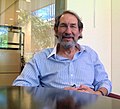Fichier:Geoffrey West.jpg

Taille de cet aperçu : 661 × 600 pixels. Autres résolutions : 264 × 240 pixels | 529 × 480 pixels | 846 × 768 pixels | 1 128 × 1 024 pixels | 1 322 × 1 200 pixels.
Fichier d’origine (1 322 × 1 200 pixels, taille du fichier : 559 kio, type MIME : image/jpeg)
Historique du fichier
Cliquer sur une date et heure pour voir le fichier tel qu'il était à ce moment-là.
| Date et heure | Vignette | Dimensions | Utilisateur | Commentaire | |
|---|---|---|---|---|---|
| actuel | 30 juillet 2007 à 11:53 |  | 1 322 × 1 200 (559 kio) | FlickreviewR | Replacing image by its original image from FlickR |
| 30 juillet 2007 à 05:44 |  | 1 024 × 930 (547 kio) | PDH | {{Information |Description= "As animals get bigger, from tiny shrew to huge blue whale, pulse rates slow down and life spans stretch out longer, conspiring so that the number of heartbeats during an average stay on Earth tends to be roughly the same, arou |
Utilisation du fichier
La page suivante utilise ce fichier :
Usage global du fichier
Les autres wikis suivants utilisent ce fichier :
- Utilisation sur ar.wikipedia.org
- Utilisation sur azb.wikipedia.org
- Utilisation sur de.wikipedia.org
- Utilisation sur en.wikipedia.org
- Utilisation sur en.wikiquote.org
- Utilisation sur fa.wikipedia.org
- Utilisation sur fa.wikiquote.org
- Utilisation sur gd.wikipedia.org
- Utilisation sur hy.wikipedia.org
- Utilisation sur it.wikipedia.org
- Utilisation sur ja.wikipedia.org
- Utilisation sur ko.wikipedia.org
- Utilisation sur nl.wikipedia.org
- Utilisation sur pa.wikipedia.org
- Utilisation sur pl.wikipedia.org
- Utilisation sur pnb.wikipedia.org
- Utilisation sur sr.wikipedia.org
- Utilisation sur sv.wikipedia.org
- Utilisation sur vi.wikipedia.org
- Utilisation sur zh.wikipedia.org
